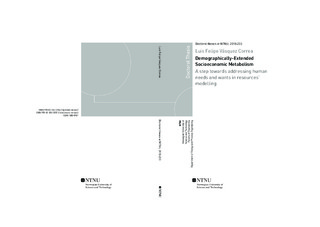| dc.contributor.advisor | Müller, Daniel | |
| dc.contributor.advisor | Hertwich, Edgar | |
| dc.contributor.author | Correa, Luis Felipe Vásquez | |
| dc.date.accessioned | 2018-09-19T12:16:57Z | |
| dc.date.available | 2018-09-19T12:16:57Z | |
| dc.date.issued | 2018 | |
| dc.identifier.isbn | 978-82-326-3257-2 | |
| dc.identifier.issn | 1503-8181 | |
| dc.identifier.uri | http://hdl.handle.net/11250/2563463 | |
| dc.description.abstract | Sustainable sociometabolic patterns are required to overcome unsatisfied needs, inequalities, and environmental problems, especially because of the expected population growth and rising living standards. To inform socioeconomic patterns that promote a resource and impact decoupled human development and well-being, it is imperative to have a comprehensive understanding of the human population, the built environment, the natural environment, and their linkages. While there is extensive research in each of these areas, the relationship between them is rarely explored. Demographic changes that affect the built environment and the use of natural resources are not currently taken into account. Therefore our ability to inform sustainability and resource decoupling policies is limited. Looking at the population in a more granular manner would allow to better account for lifestyles, cultures, and biophysical characteristics of individuals and their implications for resource use and emissions.
This thesis addresses the linkages between the population and the built environment and presents a mathematical framework for the integrated modelling of demographic metabolism and the socioeconomic metabolism with the aim of improving the understanding of human needs and their consequences for resource use. The framework builds on the premise that an integrated analysis can be based upon the differentiated needs and wants for goods and services among individuals.
The thesis illustrates the framework in the context of an European energy and greenhouse gas reduction policy in the residential sector, a housing deficit policy in Colombia, and a global policy for food-energy demand. Results show that demographic trends and changes in the biophysical characteristics of individuals can play a determining role in the effectiveness of policies – even beyond technological factors. For Europe this means that the same technology-based energy policy can lead to different reductions in energy use and greenhouse gas emissions among member states. For Colombia, this means that delaying actions to close the housing deficit increases the economic and material footprint of the residential sector. However, closing the housing deficit by 2030 as aimed, can lead to a construction industry that grows too rapidly and might be unsustainable in the long term. For global food demand, results depict an additional burden to future food security beyond the mere growth in population size, particularly because of body mass increments in most parts of the world which are partially counteracted by an aging phenomenon.
In conclusion, addressing human needs and wants in resource sustainability modelling implies to explicitly model the differentiated requirements for goods and services of different population segments. In this regard, it is essential to consider that the population stock drives the built environment stocks, and not the other way around. This framework has the potential to provide more accurate and more relevant descriptions and forecasts of infrastructure and resource use resulting from more granular descriptions of the population. | nb_NO |
| dc.language.iso | eng | nb_NO |
| dc.publisher | NTNU | nb_NO |
| dc.relation.ispartofseries | Doctoral theses at NTNU;2018:233 | |
| dc.relation.haspart | Paper 1: Vasquez Correa, Luis Felipe; Løvik, Amund Nordli; Sandberg, Nina Holck; Müller, Daniel Beat.
Dynamic type-cohort-time approach for the analysis of energy reductions strategies in the building stock. Energy and Buildings 2016 ;Volum 111. s. 37-55
http://dx.doi.org/10.1016/j.enbuild.2015.11.018 | |
| dc.relation.haspart | Paper 2:
Olaya, Yris; Vasquez, Felipe; Mueller, Daniel Beat.
Dwelling stock dynamics for addressing housing deficit. Resources, Conservation and Recycling 2017 ;Volum 123. s. 187-199
https://doi.org/10.1016/j.resconrec.2016.09.028 | |
| dc.relation.haspart | Paper 3:
Vasquez, Felipe; Vita, Gibran; Mueller, Daniel Beat.
Food security for an ageing and heavier population.
- The final version is available in
Sustainability 2018 ;Volum 10.(3683) s. 1-19
https://doi.org/10.3390/su10103683
This article is an open access
article distributed under the terms and conditions of the Creative Commons Attribution
(CC BY) license (http://creativecommons.org/licenses/by/4.0/). | |
| dc.title | Demographically-Extended Socioeconomic Metabolism: A step towards addressing human needs and wants in resources’ modelling | nb_NO |
| dc.type | Doctoral thesis | nb_NO |
| dc.subject.nsi | VDP::Technology: 500::Environmental engineering: 610 | nb_NO |
